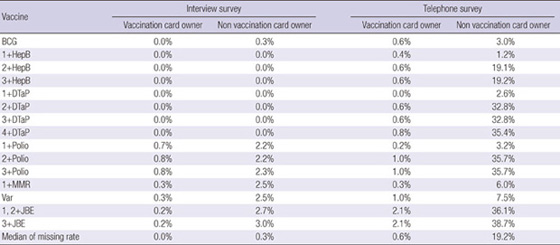1. Odusanya OO, Alufohai EF, Meurice FP, Ahonkhai VI. Determinants of vaccination coverage in rural Nigeria. BMC Public Health. 2008. 8:381.
2. Burton A, Monasch R, Lautenbach B, Gacic-Dobo M, Neill M, Karimov R, Wolfson L, Jones G, Birmingham M. WHO and UNICEF estimates of national infant immunization coverage: methods and processes. Bull World Health Organ. 2009. 87:535–541.
4. Bowling A. Mode of questionnaire administration can have serious effects on data quality. J Public Health (Oxf). 2005. 27:281–291.
5. Donovan RJ, Holman CD, Corti B, Jalleh G. Face-to-face household interviews versus telephone interviews for health surveys. Aust N Z J Public Health. 1997. 21:134–140.
6. Korean Institute for Health and Social Affairs. Nationwide survey of children vaccination coverage. 1989. Seoul: Institute for Health and Social Affairs, Ministry for Helath, Welfare and Family Affairs.
8. Lwanga SK, Lemeshow S. Sample size determination on health studies: a practical manual. 1991. Geneva: World Health Organization;1–5.
9. Macro International Inc. DHS-III Basic Documentation No6. Sampling manual. 1996. Maryland: Macro International Inc.
12. Kempf AM, Remington PL. New challenges for telephone survey research in the twenty-first century. Annu Rev Public Health. 2007. 28:113–126.
13. National Immunization Survey Guide to Quality Control Procedures. Centers for Disease Control and Prevention. accessed on 1 May 2010. Available at
http://www.cdc.gov/nis/pdfs/qcman.pdf.
14. Statistical Methodology of the National Immunization Survey, 1994-2002. Series 2 (Number 138). U.S. Department of Health and Human services. accessed on 1 May 2010. Available at
http://cdc.gov/nis/reports.htm.
15. National Immunization Survey-A users' Guide for the 2006 Public-use data file. National Opinion Research Center. accessed on 1 May 2010. Available at
http://www.cdc.gov/nis/data_files.htm.
16. Ministry of Health and Family Welfare Government of India. District Level Household and Facility Survey 2007-08. 2010. Mumbai: International Institute for Population Science, Deemed University.
17. Report on National Health and Nutritional Examination. Ministry of Health and Welfare. accessed on 10 March 2011. Available at
http://knhanes.cdc.go.kr/.
18. Park K, Eun SJ, Lee EJ, Lee CE, Park DY, Han K, Kim Y, Lee JS. The incidence and patterns of unintentional injuries in daily life in Korea: a nationwide study. J Prev Med Public Health. 2008. 41:265–271.
19. Kwon YC, Shin DW, Lee JH, Heo DS, Hong YS, Kim SY, Yun YH. Impact of perception of socioeconomic burden on advocacy for patient autonomy in end-of-life decision making: a study of societal attitudes. Palliat Med. 2009. 23:87–94.
20. Jeong JS, Choi JK, Jeong IS, Paek KR, In HK, Park KD. A nationwide survey on the hand washing behavior and awareness. J Prev Med Public Health. 2007. 40:197–204.
21. Siemiatycki J. A comparison of mail, telephone, and home interview strategies for household health surveys. Am J Public Health. 1979. 69:238–245.
22. Novick G. Is there a bias against telephone interviews in qualitative research? Res Nurs Health. 2008. 31:391–398.
23. Rhim JW, Kim CH, Lee WB, Kang JH. A survey of parental knowledge of vaccination. Korean J Pediatr. 2006. 49:251–257.
24. Korean Institute for Health and Social Affairs. 1994 Korea National Fertility Survey. 1994. Seoul: Institute for Health and Social Affairs, Ministry for Helath, Welfare and Family Affairs.
25. Korean Institute for Health and Social Affairs. 2000 Korea National Fertility Survey. 2000. Seoul: Institute for Health and Social Affairs, Ministry for Helath, Welfare and Family Affairs.
26. Hoshaw-Woodard S. Description and comparison of the methods of cluster sampling and lot quality assurance sampling to assess immunization coverage. 2001. Geneva: World Health Organization.
27. Barreto TV, Rodrigues LC. Factors influencing childhood immunisation in an urban area of Brazil. J Epidemiol Community Health. 1992. 46:357–361.
28. Rosenthal J, Rodewald L, McCauley M, Berman S, Irigoyen M, Sawyer M, Yusuf H, Davis R, Kalton G. Immunization coverage levels among 19- to 35-month-old children in 4 diverse, medically underserved areas of the United States. Pediatrics. 2004. 113:e296–e302.
29. Falagas ME, Zarkadoulia E. Factors associated with suboptimal compliance to vaccinations in children in developed countries: a systematic review. Curr Med Res Opin. 2008. 24:1719–1741.









 PDF
PDF ePub
ePub Citation
Citation Print
Print




 XML Download
XML Download